Featured Posts
Airline Seating Gets Reimagined
By Daniel Wood for PeterGreenberg.com
When the COVID-19 pandemic began in early 2020, it sent airlines scrambling. All airline companies were challenged to implement health policies that would keep travelers and employees safe. Strict mask mandates and demands for social distancing forced airlines to consider new configurations of aircraft cabins to increase passenger comfort while maintaining the same level of seating.
Both Boeing and Airbus concentrated on airframe sizing, route structures and fuel efficiency to maintain profitability. Meanwhile, private companies took on the challenges of imagining aircraft cabins of the future. These suppliers have designed seating configurations like nothing seen before that provide a look at what future cabin interiors might look like. Their concepts suggest how to creatively maximize the use of space on board commercial aircraft while also providing customers with an enjoyable flying experience.
Zephyr Aerospace is one supplier which has reimagined onboard seating. The company is working to change economy class seating as we know it. It has designed a revolutionary double-decker seating concept in which seats are stacked upon one another, allowing every economy class seat to have the capability to lie completely flat. Currently, lie-flat seats are only offered in business and first-class cabins.
The ‘Zephyr Seat’ would allow airlines to offer an exceptional passenger experience, even within the economy class cabin. The stackable concept of the seats also allows for more space between passengers, which facilitates social distancing in the age of COVID-19.
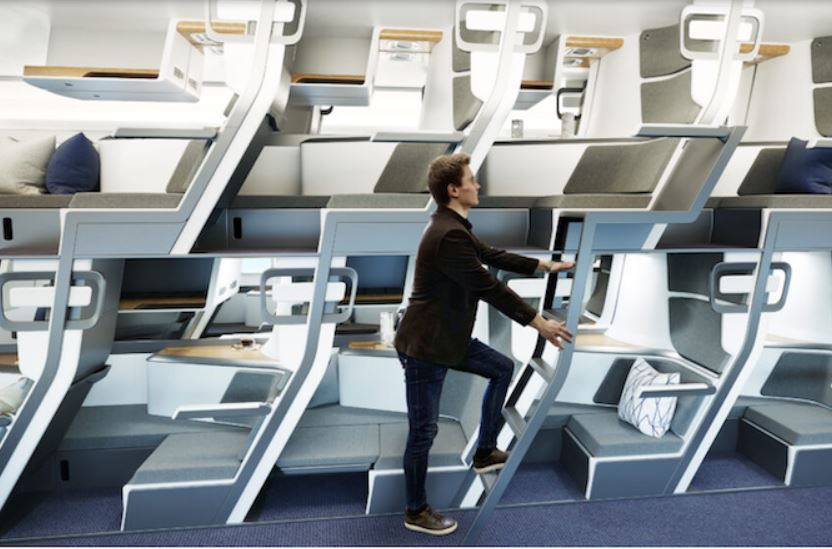
The stackable design of the Zephyr Seat allows for coach passengers to be comfortably spaced apart, with each guest essentially sitting in their own semi-private cubicle. The Zephyr seating arrangement removes many negatives of economy travel, such as lack of privacy, cramped rows and passengers sitting shoulder to shoulder. Seats will be stacked, with passengers on the second level having their own individual access ladders and an increased measure of privacy.
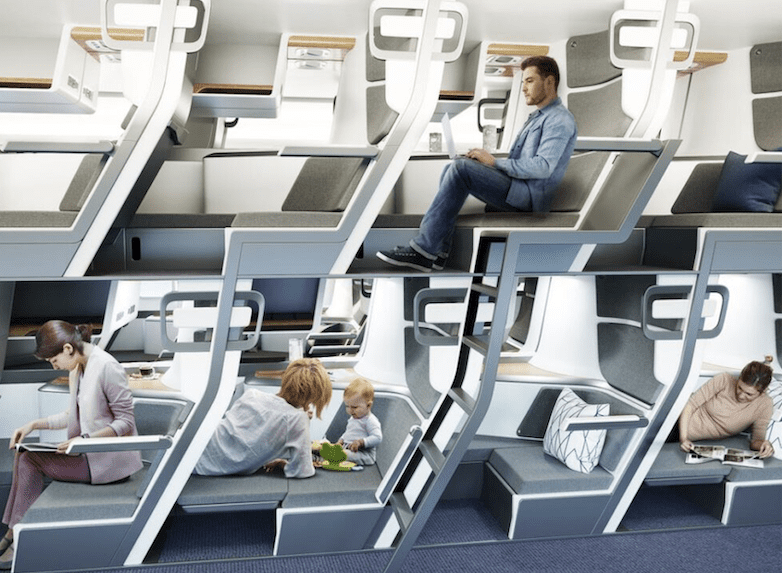
Photos by Zephyr Aerospace
And it is not the only new seating design within the airline design industry. The company Paperclip Design has created a seating solution to help airlines with issues such as having too few or too many business class seats. The design is called ‘Checkerboard’ and its goal is to provide seating flexibility that can be made in a matter of minutes.
Airlines are consistently faced with the problem of predicting the demand for how many first class, business, or economy seats a specific flight may need and filling those seats to satisfy each customer’s need. With the same airplane often being used on different routes throughout the day, that only further complicates space management.
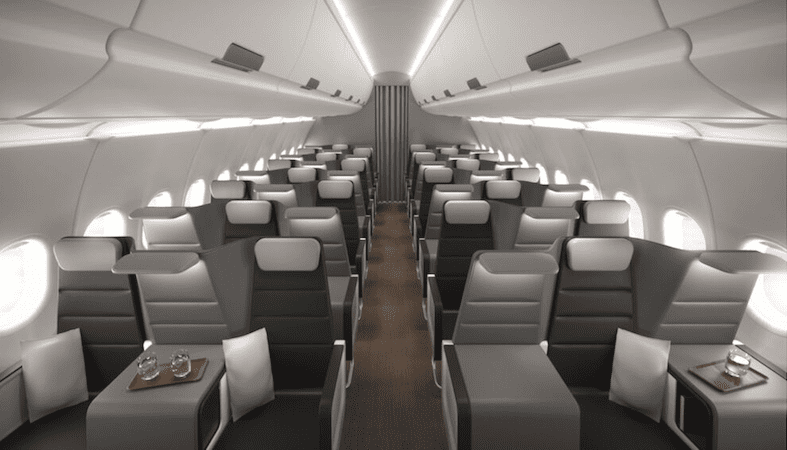
The ‘Checkerboard’ seat design allows for airline employees to quickly change seating configurations to meet the demand for each flight. The design can allow for one row to sit only one person, providing business class level comfort. The flexible seating arrangement can allow the next row to sit three people, providing more of a standard economy feel. Photo by Butterfly Seats
For example, an aircraft may have a daily schedule from Atlanta to Los Angeles, Los Angeles to Seattle, and then Seattle back to Atlanta. The ATL to LAX flight may have more passengers who want to fly business class, while the LAX to SEA may have more demand for economy class. If the airline is able to switch seating between economy and business class, it can maximize profit for each leg of its schedule.
Paperclip Design believes it has a solution to this problem. The Hong Kong-based company has created a seating concept it calls the ‘Checkerboard,’ which essentially will allow airlines to adapt their business class seating depending on demand.
The duality of the seat design makes the product unique. As an economy seat, it will still have the essentials – such as tray tables, seat pockets, maximum legroom, and a high pivot recline. As a business class seat, the cushion of the unused seat folds up and forward, providing an extra comfortable seat and armrest for passengers. When the unused seat cushions are folded up and forward into the business class position, the seatback also swings forward, which creates additional space for the passenger. The business seat design creates an extra eight inches of legroom compared to an economy seat.
This design may change the future of the business class cabin, which has looked much the same for years. Current business class seats provide comfort and luxury for passengers, but airlines are not always able to fill all the more expensive seats.
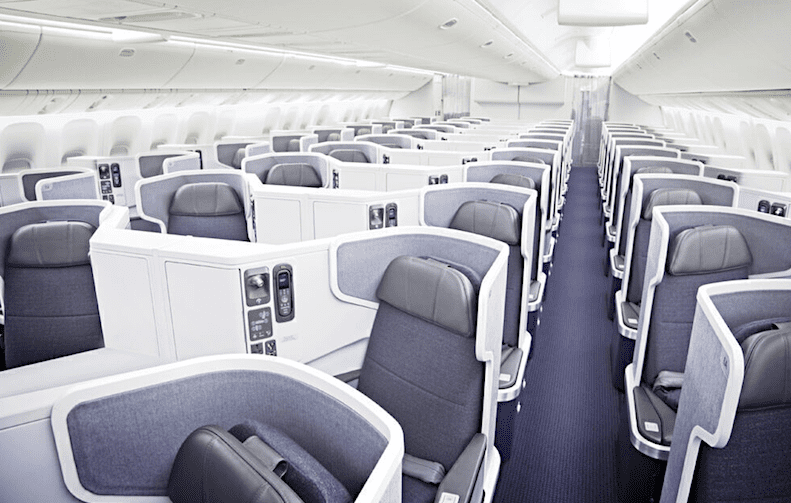
Current business cabins, like the one above from American Airlines, are appealing to the eye and get the job done. However, the ‘Checkerboard’ seat could help resolve the issue of airlines not always being able to fill each seat and bring more versatility into the business and economy cabins. Photo by American Airlines
Many business cabin’s seats, like the ones below from Qatar Airways, try to provide a “suite” feel to each seat. The ‘Checkerboard’ seat design does not provide this level of luxury, but it does give airlines more flexibility when it comes to making sure every seat is filled. Photo by Qatar Airways

Another seating concept is from design company Rebel.Aero. Its new seat design, ‘Joy’, could help end armrest competition. ‘Joy’ is an ultra-lightweight seat with the middle seat slightly offset from the window and aisle seats, creating a staggered design. This means reduced shoulder and armrest contact between passengers. The ‘Joy’ design also has a spring-loaded ‘flip-up booster’ seat that can fold up to allow for more standing space, thereby making it easier to board and exit the aircraft.
Instead of complete redesigns of seating arrangements, some companies and designers shifted towards minor adjustments to cabin interiors. Many of the companies who designed these seating enhancements were named winners at the 14th Crystal Cabin Awards, which could be compared to the “Oscars” for aircraft interior design. These were revealed on March 30th and have given us a true glimpse into what the future of aircraft cabins might look like.
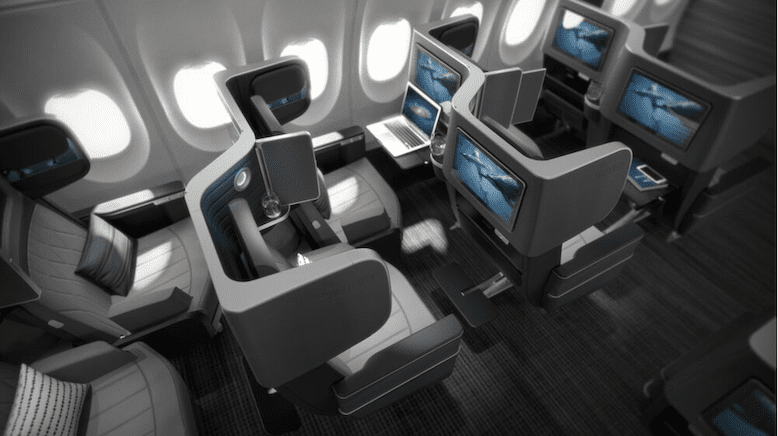
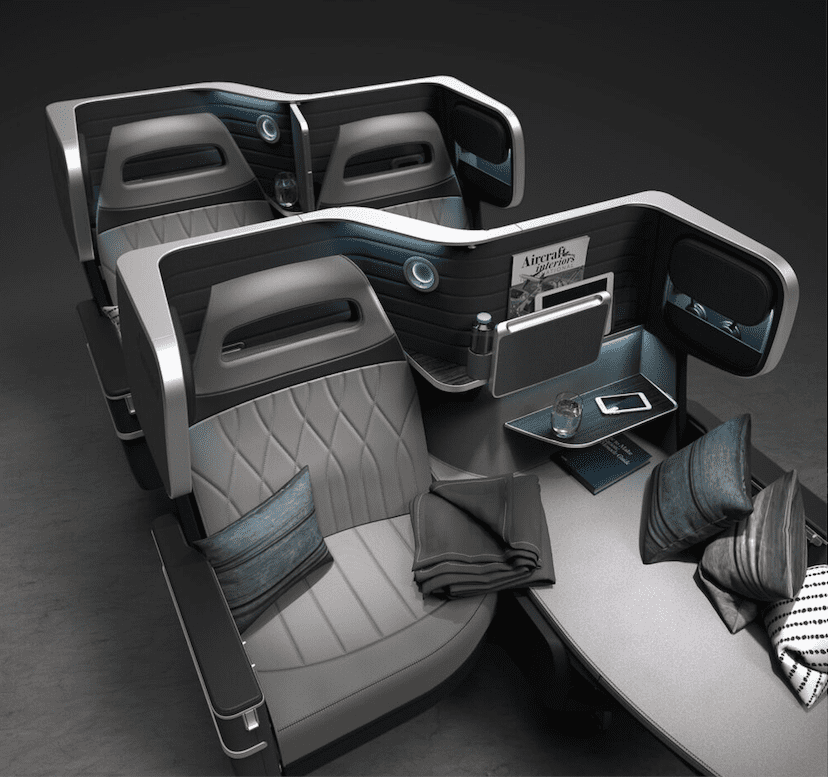
When arranged in a two-seat configuration above, the staggered Butterfly seat makes for a comfortable premium economy configuration. By stationing one seat slightly in front of the other, passengers enjoy the illusion of more space. On a flight with more demand for business class, one of the same two seats pictured below can be speedily reconfigured to provide more privacy for one person enjoying the higher priced amenities of premium travel. Both photos by Paperclip Design.
The company Safran has designed their ‘Modulair Seat’ which is a set of modular comfort units that can be added to existing seats. These comfort units include things like neck supports and tablet holders.
Accessibility is also on the minds of forward looking designers. Designer Ciara Crawford tackles the issue of independence for passengers with reduced mobility through her “Row 1” airport wheelchair design.
Sustainability is also considered in these new seating designs. Canadian company e2ip Technologies has developed in-mold electronic technologies, such as surface printed electrical circuits and buttons. This will allow for the possible elimination of heavy cabin electronics, which will reduce pollution since added weight produces added pollution. To increase sustainability and lower expenses, Diehl Aviation has designed a way to recycle water from the sink and toilet on board.
The visionary concept award was given to Airbus for their Airspace Cabin Vision 2030. The vision for Airbus moving forward is to provide a more personalized experience to passengers by merging the concepts of digital technology and customer experience. Customers may be able to select their preferences in advance via the internet or an app to suit their own requirements, such as traveling with children or flying solo.
At the Crystal Cabin Awards, the cabin concept award this year, the award was given to a company whose focus was on seating arrangements. The award was given to Eviation for its all-electric commuter plane known as Alice. The aircraft would feature a 1 by 1 asymmetric seating layout, which was first revealed in 2019 at the Paris Air Show.
The company Adient designed a ‘Seat For All (SFA)’ – which is a seating extension for passengers that travel in groups such as families. The product allows a row of three seats to turn into a bed for multiple people.
Private companies like Adient are considering new ways for airline customers to be comfortable. Airlines themselves are examining these new designs. They are also going beyond reconfiguring traditional airline seats’ and are considering how to create a more social environment on board a flight. Japan’s All Nippon Airways (ANA) will be offering their Boeing 777 cabin as a wedding venue for a few lucky couples soon. Perhaps ANA will be the first airline to use designs from Adient, or even Eviation, providing ultimate seating comfort and ultimate experiences in the sky.
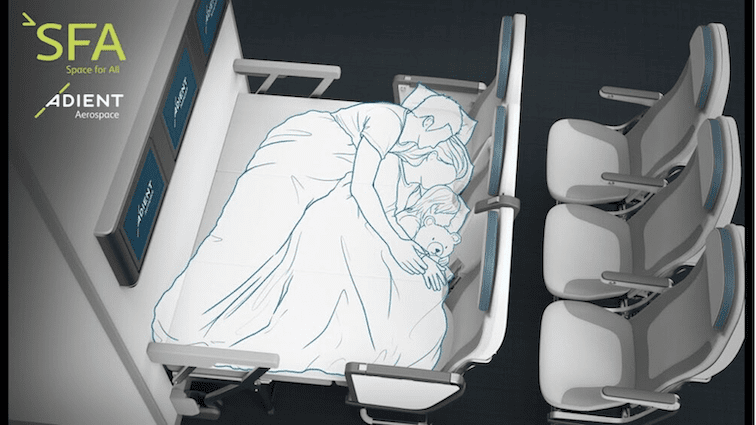
The company Adient designed a ‘Seat For All (SFA)’ – which is a seating extension for passengers that travel in groups such as families. The product allows a row of three seats to turn into a bed for up to three people. All Nippon Airways may find the SFA popular with newlyweds on one of its wedding flights. Photo by Adient
It appears airline interiors will likely see many changes in the years to come. Many designs are under active consideration by major airline companies, and manufacturers continue to develop new products and designs. For those who do not fly regularly, you might not recognize the interior design of the plane you board next. Frequent flyers may begin to see gradual changes to aircraft interiors in the near future.












